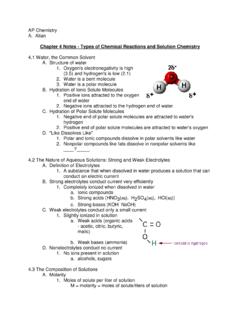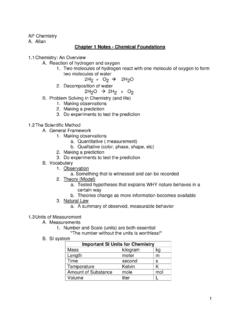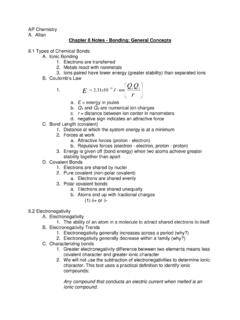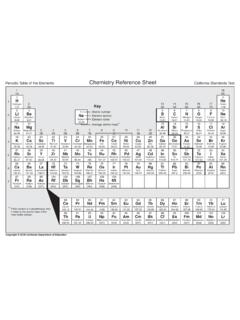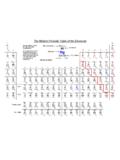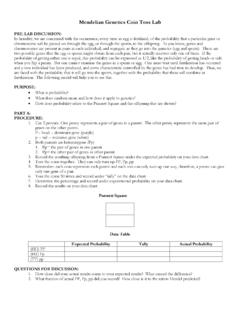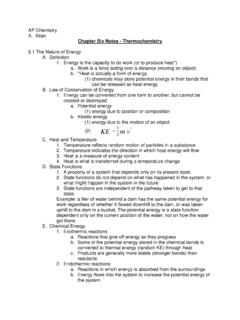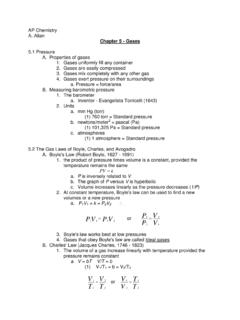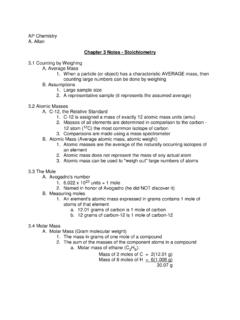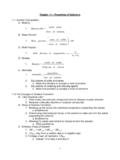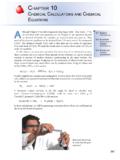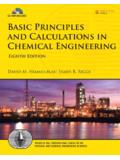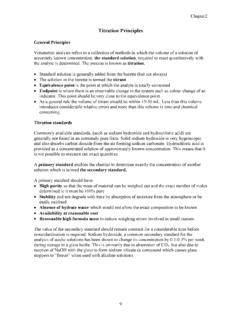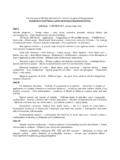Transcription of Chapter 12 - Chemical Kinetics - ScienceGeek.net
1 1 Chapter 12 - Chemical Kinetics Reaction Rates A. Chemical Kinetics 1. Study of the speed with which reactants are converted to products B. Reaction Rate 1. The change in concentration of a reactant or product per unit of time [ ]tAttttimeatAofionconcentratttimeatAofio nconcentratRate = =1212 a. Rates decrease with time b. It is customary to express reaction rates as positive values c. Instantaneous rate can be determined by finding the slope of a line tangent to a point representing a particular time C. Decomposition of NO2 2NO2(g) 2NO(g) + O2(g) Rate of consumption of NO2 = rate of production of NO = 2(rate of production of O2) []tNO 2 = [ ]tNO = [ ] tO22 2 Rate Laws: An Introduction A.
2 Reversibility of reactions 1. For the reaction 2NO2(g) 2NO(g) + O2(g) The reverse reaction 2NO(g) + O2(g) 2NO2(g) may also take place 2. The reverse reaction effects the rate of change in concentrations a. [A] depends on the difference in the rates of the forward and reverse reactions B. Rate Law (Ignoring reverse reaction) 1. Rate = k[NO2]n a. k is a proportionality constant called the rate constant n is the order of the reactant (an integer, including zero, or a fraction) (1) k and n must be determined experimentally 2. Concentrations of products do not appear in the rate law C.
3 Types of Rate Laws 1. Differential Rate Law (Rate Law) a. Expresses how the rate of a reaction depends upon concentration Rate = k[NO2]n 2. Integrated Rate Law a. Expresses how the concentration of a species (reactant or product) in a reaction depend on time []tNO 2 = [ ]tNO = [ ] tO22 3. Choice of rate law depends on what data is easiest to collect **Why study rate law? Re-read the paragraph at the bottom of page 556. Determining the Form of the Rate Law A. Determining the value of n (Order of the reactant) 1.
4 Example [A] Rate (mol/L s) M x 10-3 M x 10-3 a. Doubling the concentration of species A quadruples the rate of the reaction. Therefore, the reaction is of second order with respect to A Rate = k[A]2 B. Method of Initial Rates 1. Initial rate a. Instantaneous rate just after t = 0 2. Experimental method a. Vary initial concentration of reactant(s) b. Determine initial rate for each concentration c. Examine relationship between rate and initial concentration 3 3. Example: Table 12-4 Intial Rates from Three Experiments for the Reaction: NH4+(aq) + NO2-(aq) N2(g) + 2H2O(l) Experiment Initial Concentration Of NH4+ Initial Concentration Of NO2- Initial rate (mol/L s) 1 M M x 10-7 2 M M x 10-7 3 M M x 10-7 a.
5 In experiment 1 and 2, the concentration of NH4+ is held constant b. In experiment 2 and 3, the concentration of NO2- is held constant c. Basic rate law for the reaction: Rate = k[NH4+]n[NO2-]m 4. Calculations a. Experiment 1 and 2 (1) Rate doubles when concentration of NO2- doubles (2) m = 1 (first order) b. Experiment 2 and 3 (1) Rate doubles when concentration of NH4+ doubles (2) n = 1 (first order) 5. Overall reaction order a. Overall reaction order is the sum of m and n (1) m +n = 2 so overall the reaction is second order Rate = k[NH4+][NO2-] 6. Calculate k, the rate constant a.
6 Rate is known b. Both concentrations are known c. Exponents are known x 10-7 mol/L s = k( M)( M) k = x 10-7 mol/L s ( M)( M) The Integrated Rate Law A. Integrated First-Order Rate Law (single reactant) 1. ln[A] = -kt + ln[A]0 or [ ][ ]ktAA= 0ln a. [A] is concentration of reactant A at time = t b. [A]0 is concentration of reactant A at t = 0 c. Equation is linear (y = mx + b) 2. Half-life of a First -Order Reaction a. Half life of a reaction is the time required for a reactant to reach half its original concentration [ ][ ]ktAA= 0ln [ ][ ]20AA= [ ][ ]2/1002/lnktAA= ( )2/12lnkt= kt)2ln(2/1= 4 B.
7 Integrated Second-Order Rate Law (single reactant) 1. [ ][ ]011 AktA+= a. Graph of 1/[A] versus t is a straight line with slope k 2. Half-life of a Second-Order Reaction (derivation on page 567) a. [ ]02/11 Akt= b. For a second-order reaction each successive half-life is double the preceding one C. Zero Order reactions 1. Rate is constant; it does not change with changing concentration 2. Zero order sometimes happens with catalysis 3. Integrated rate law for zero-order reactions a. [ ][ ]0 AktA+ = 4. Half-life of a zero-order reaction a. [ ]kAt202/1= D. Integrated Rate Laws for Reactions with More than One Reactant 1.
8 Examine rate with one reactant in very low concentration and the others much higher Rate = k[A]n[B]m[C]p a. If [B]> >[A] and [C] > >[A] then [B] and [C] do not change as greatly relative to [A] Rate = k'[A]n 2. Pseudo-first-order rate law (or zero-order , or second-order) a. Simplification yields a rate law of a particular order Reaction Mechanisms A. Reaction Mechanism 1. A series of elementary steps that must satisfy two requirements a. The sum of the elementary steps must give the overall balanced equation for the reaction b. The mechanism must agree with the experimentally determined rate law B.
9 Intermediates 1. A species that is neither a reactant nor a product, but that is formed and consumed during a Chemical reaction C. Elementary steps 1. Reactions whose rate law can be written from their molecularity (balanced eqn for the step) 5 D. Molecularity 1. The number of species that must collide to produce the reaction indicated by that step a. Unimolecular step - a reaction involving one molecule b. Bimolecular step - reaction involving the collisions of two species c. Termolecular step - reaction involving the collisions of three species Table Examples of Elementary Steps Elementary Step Molecularity Rate Law A products Unimolecular Rate = k[A] A + A products (2A products) Bimolecular Rate = k[A]2 A + B products Bimolecular Rate = k[A][B] A + A + B products (2A + B products) Termolecular Rate = k[A]2[B] A + B + C products Termolecular Rate = k[A][B][C] E.
10 Rate-Determining Step 1. The slowest step in a reaction determines the rate of the reaction F. Example 1. Overall rxn: NO2(g) + CO(g) NO(g) + CO2(g) 2. Rate law determined experimentally: Rate = k[NO2]2 3. Elementary Steps NO2(g) + NO2(g) 1k NO3(g) + NO(g) NO3(g) + CO(g) 2k NO2(g) + CO2(g) 4. Which step is rate determining? a. IF step 1, Rate = k[NO2]2 (1) this agrees with experimental results b. IF step 2, Rate = k[NO3][CO] (1) this does not agree with experimental results A Model for Chemical Kinetics A. Collision Model 1.
